 |
 |
 |
|
News & Notices
News From:
Commissions
Conference & Stage Expo
For the Record
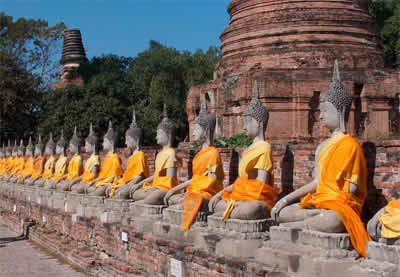 |
Ayuthaya is the site of the ancient ruins of the temples of the early ages in Thailand work (example left), one of many stops for those on the Southeast Asia Study Tour.
|
|
|
A Magical Tour of
Southeast Asia In the middle of January, 29 weary, travel-worn souls returned from an exhilarating trip to Thailand, Cambodia, and Vietnam as part of the most recent Study Tour sponsored by USITT. Once again, participants celebrated the creative cultures of other countries, met counterparts in the business of theatre in its broadest scope, saw incredible sites (among the most beautiful in the world), made good friends with fellow USITT travelers, and met some lovely, gracious people in every country. The memories of every stop, layers of images of Royal Palaces and floating markets are with tour goers always, just on the edges of consciousness. Participants traveled to Bangkok, the first stop, in two groups, departing from both east and west coasts of the United States. In either instance, it was one long flight and the group staggered to the common meeting spot in Taipei to finish the last leg of the journey, bleary from nearly 20 hours in transit. Group members arrived at the Bangkok hotel, checked in and, rather than waste precious time, a few immediately set off for the Jim Thompson House of Silk museum. Mr. Thompson was an American entrepreneur who is credited with saving the silk industry in Thailand. He brought good old American business acumen to Bangkok, and relocated a series of structures to assemble a lovely traditional-styled home and business on the bank of a canal -- the primary, efficient mode of transportation throughout the city. While the silk fabrics and clothes on sale in the shop were lovely, this was the first introduction to the domestic architectural style, very stunning, yet charming and comfortable. Travelers endured an endless coach ride through traffic to get to this site. We did discover that every journey across Bangkok was a trial. Two and a half million citizens of Bangkok travel by motorbike, darting in and out of the traffic, swirling, and swerving around cars, buses, and startled Americans. The noise when any traffic light turns green is like the starting flag at Indy, but with a slightly higher-pitched whine and roar. As the group traversed the city, we quickly understood why the motorbikes and tuk-tuks (below) were the preferred method of travel rather than a lumbering tour bus. 
That night, members had the first of a marvelous set of adventures with Thai massage, courtesy of our travel partners, Mongol Global Travel, and Owner/President Russ Oquist. Everyone had a lovely time and what a relaxing way to finally get ready for a sleep that seemed days in coming! The sights of the next few days were stunning as we crisscrossed Bangkok, then in and out of the city, seeing one incredible site or structure after the other. These digital photos may give you a sense of the experience, but without the sounds, smells and voices, they are but a hollow replica. The Reclining Buddha Temple and the acres of gold-laden structures, bas-reliefs, and statuary of the surrounding Royal Palace are almost beyond even a designer's imagination. The broken-tile work of the facades is like pointillism as viewed from even a few feet away. The symmetry of the majestic rooftops and arches is simply breathtaking. The connections made with people were the highlights of this tour. The memory of the students at the several academies visited, including the Wittayalai Natthasin, the College of Dramatic Arts (grades 7-12) in Bangkok, evokes a smile. The training for careers in traditional music, dance, and acrobatics (below) is a way out of poverty, yet also serves to pass these cultural touchstones on from older generations to the youth. The seriousness and dedication is phenomenal -- the angle of the arm, the impossible curve of the fingers, the relationships of the feet, every gesture and pose is practiced to perfection. 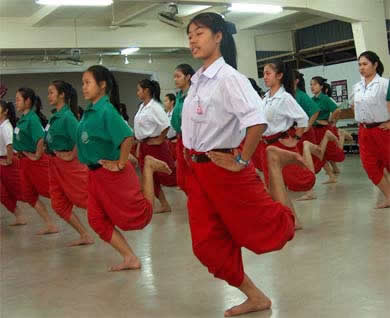
Of course, many know the mask and puppet theatre traditions of the Far East. The group's first formal introduction and instruction was at the Joe Louis (not the boxer) Puppet Theatre. As participants arrived early at the theatre, the mask-makers invited them to watch their process. Then we were invited into the dressing rooms to see, handle, and operate the sophisticated puppets seen in the production that evening. The craftsmanship was superb, so detailed and precise. Our first journey into the countryside, with a planned visit to the Floating Markets, was a sensory delight -- nothing to do with theatre and everything to do with it. Travelers left early to be the first on the grounds of the Imperial Summer Palace, the first stop. The temperature was perfect with bright sun as we walked the parkland. The grounds were reminiscent of English formal gardens with Capability Brown-like lakes in the foreground and stunning flowers and architecture from the Chinese pagoda (a gift to the Royal family) to Baroque, to Art Deco. It was difficult to leave this place. But, on to the markets!
Late that afternoon, the group returned to the city for a lovely, official visit to the Thai National Theatre of Bangkok. We accepted an invitation to a traditional dance and music performance that evening. All enjoyed seeing the similarities of the traditional performances, whether the live performers in this space, or the puppet theatre the night before; the mythologies and characters were so similar, and it was enjoyable to begin to understand and appreciate the stories every child in Thailand knows. The costume technicians volunteered to dress three of the performers while the group watched, to see the intricate wrapping and folding of the costumes. The process took over an hour! A lesson, repeated several times over the course of the almost-three weeks, was learned: traditional performances are very long, and often there are no breaks -- you simply get up when you need to. Ayuthaya is the site of the ancient ruins of the temples of the early ages in Thailand. This place was very similar in feel to those seen later in the tour at Angkor Wat in Cambodia. Several group members climbed the central tower, a trek repeated in Cambodia. The land is so flat, you can see for several kilometers between the trees. Once back in Bangkok (hey, this is New Years Eve!), some of the brave souls ventured back into the city for the celebration. Oh, do the Thai love fireworks…loud fireworks. The Ruins of Cambodia It was the New Year, and the group departed for Cambodia and some of the most spectacular temple ruins on the planet -- Angkor Wat. The people were among the most gracious we encountered -- courteous and generous in spite of the poverty. Siem Reap, the only city of any size near the mega-complex of the Wats, is a maze of tourist hotels, many in various stages of construction, as the city and government try to capitalize on the interest in what has to be one of the true wonders of the world. Angkor Wat is perhaps the best known, but not the largest, of the various walled "cities" that surround the city of Siem Reap. Because much of the land has been cleared around Angkor Wat, at least on some of the approaches, it is perhaps the most dramatic, since you can get far enough away from it to really appreciate the scale. Unlike so many monuments in other parts of the world that have been barricaded to keep tourists from contributing to the decay of millennia, most of the Wats are open and you can climb any portions you dare. OSHA would have a field day here. The steps to the central tower in Angkor Wat are incredibly treacherous, rather like climbing Coba in the Yucatan of Mexico, where you have to transverse the steps to find a reasonable way to get up and down. One of the most remarkable experiences was coming upon a monk at the base of the Buddha inside the central tower. The sound of his instrument, the heavy, sweet smell of the incense, and the flickering light from the small fires, then rounding the corner to see him, was almost mystical. When the walled temples were "rediscovered" and the government realized the potential for worldwide interest, each temple was assigned to archeological teams from different countries. A brilliant move, it meant that Cambodia didn't have to pay for the unbelievable task of rescuing the temples from the clutches of the jungle. Each country mounted an effort to rebuild "its" site. To illustrate, you have to understand what the temples were like before these efforts began. Only one, Ta Prohm, remains in the original state. Nothing escapes popular culture. Some of the location shots for Laura Croft, Tomb Raider were done here. Over the span of 900 years, you can see that the jungle, the elements, even earthquakes began to reclaim these man-made sites. Only when you see Ta Prohm, do you begin to understand the enormity of the conservation and stabilization efforts required to extricate the entire complex of temples. A favorite photo is of one of the far corners of Ta Prohm (below) almost like a Disney World construction. 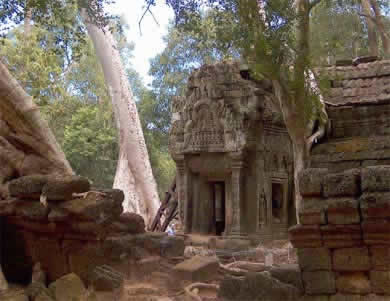
That evening, exhausted but exhilarated, we were treated to a traditional Cambodian music and dance show at a purpose-built presentation hall and restaurant. Again, the similarities of the dances and mythology to those in Thailand were striking. The group was invited on stage to view the costumes, adding to the sensory stimulation of the day. Most collapsed, exhausted, at the end of the day. Even with the overwhelming visual sites of Angkor Wat, the next day at Banteay Srei, was a favorite in Cambodia. This comparatively small temple was very accessible and the sandstone carvings are remarkable and inexplicably preserved. The intricacy of the detail is stunning and the site is serene (few tourists journey this far from the main temples), about an hour into the jungle. On the way back the group stopped at a small village to purchase some fabrics, carvings, and palm sugar delicacies. The oxcart transport joined the road with the vans and trucks in an unusual juxtaposition. The ever-present water buffalo simply grazed outside the stilted houses. On to Saigon and Beyond "The American War is forgotten; what's in the past is in the past." The first guide in Vietnam provided this quote as the mantra for tourism in Vietnam; seemingly, the major hope out of the extreme poverty, especially in the north, brought about by the economic sanctions that were lifted in the late 1990s. The grand historical structures of Saigon are lovely, majestic remnants of the early French years. The group visited Notre Dame and the City Post Office, side by side in the center of the city, beautifully preserved. Much of the afternoon and evening were spent first in official meetings with the Director of the National Theatre Opera House Nguyēn Thi Thú Nga and Vietnamese government and cultural representatives, and then in tours of the beautiful neoclassical building, and finally as guests for a contemporary music event being broadcast live on Vietnam television. The theatre is the finest in the country, and the technicians welcomed participants as colleagues and were eager to show them around the facility. The group flew to Danang, known to many as the site of the major American military location during the war. The Museum of Antiquities and most of the city remains as it was 35 years ago. This was a very fast stop since the group was to drive through the countryside to Hue, the cultural capital of Vietnam -- the last city before crossing the old Demilitarized Zone. Before dusk, members saw miles of rice paddies still planted and cultivated with the same techniques used for hundreds of years. Unfortunately, after the first morning at the Mieu Temple and Pagoda in Hue, the skies opened, reminiscent of tropical monsoons. The group had a lovely visit to the Imperial Citadel built in 1805, which survived the Tet Offensive bombing of 1968. We were invited to a very special ethnic music and dance performance inside the Citadel. The performance is so important in the Vietnam history that it has been conferred with World Heritage status. Late in the afternoon, part of the group relaxed in the hotel to escape the rain, while the remainder toured the fantastic Royal Tombs, so similar in feel to those in China outside Beijing. The farther the group traveled north, the more we seemed headed back in time. More sidewalk vendors sold food from poles balanced across their shoulders which, while not unusual in Saigon, appeared commonplace in the north particularly in the Dong Ba Market in Hue and in Hanoi, the last major stop on the tour. The hotel in Hanoi was lovely and an easy walk from the Old Quarter of the city, a maze of streets and shops.
The highlight of the tour was a visit to the countryside, to one of the training centers of water puppetry in Vietnam. The water puppet theatre is at the heart of this small village where the puppeteers stand in the water behind a screen and manipulate the puppets, with rods and poles under the water, accompanied by music. The historical aspects were worth the visit, as the secrets of the water puppets have been guarded through generations. Traditionally, even family members were not permitted "back stage." It was a tribute to the connections of Mongol Global Tours that the group was afforded this rare opportunity. However, it was the interactions with the townspeople and children that made this visit so special. Children who were studying rudimentary English were brought to meet us by their teacher. The village is far into the countryside, well off the beaten track, and USITT group members were truly unusual. There was no begging, no hawking of goods, just people intrigued by the very tall Americans. It was spectacular and moving. A little one cautiously took my wife's finger and walked alongside her to the theatre. Ha Long Bay Ha Long Bay has been described as one of the jewels of the world (below) so remote and so beautiful, compared by many to the Yellow River in China. The group of islands that make up Ha Long Bay are themselves a World Heritage site, and participants spent the night onboard two ships. The camaraderie of the evening was particularly enjoyable because members knew the adventure was about to end. Sadly, these photos do not do justice to the majesty and serenity of this place. The juxtaposition of the cave on one of the islands, the junks floating in the harbors, the sunset (after days of gray clouds), which magically appeared at the very moment the group sailed out of one of the harbors. The climb to the pagoda…memories, and friendships. 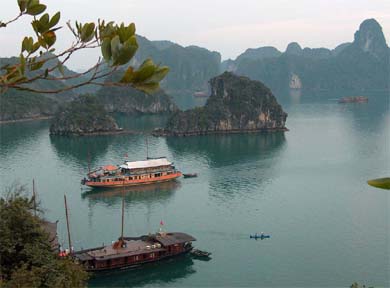
|
At Angkor Wat, tour participants came upon a monk at the base of the Buddha inside the central tower. 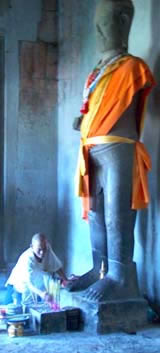  |
|
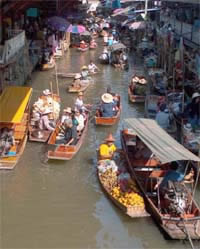 The coach dropped the group canal-side, where members rode longboats, each powered by a monstrous engine hooked to an ingenious, direct drive propeller that provided a ride almost as scary as dodging the motorbikes in the city, lunging through back-alley canals, with houses on stilts on both sides, through narrow passages, until they arrived at the markets. Looking past the tourist stalls selling T-shirts along the canals, there were people selling food clothing, drinks -- almost every essential -- right out of the boats. Previously unknown fruits that were out of this world were sampled. While slurping them down, travelers wondered what the Center for Disease Control would say about eating this fruit right from the vendor, and where, and if, that fruit had been washed.
The coach dropped the group canal-side, where members rode longboats, each powered by a monstrous engine hooked to an ingenious, direct drive propeller that provided a ride almost as scary as dodging the motorbikes in the city, lunging through back-alley canals, with houses on stilts on both sides, through narrow passages, until they arrived at the markets. Looking past the tourist stalls selling T-shirts along the canals, there were people selling food clothing, drinks -- almost every essential -- right out of the boats. Previously unknown fruits that were out of this world were sampled. While slurping them down, travelers wondered what the Center for Disease Control would say about eating this fruit right from the vendor, and where, and if, that fruit had been washed.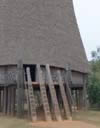 The Museum of Ethnology was simply stunning -- a visual history of the country and its people: homes reconstructed on the site, traditional costumes separated by region and ethnicity, even videos of marriage ceremonies from the historic cultures. This wonderful museum, an attempt to preserve the cultural heritage of fast-disappearing ethnic groups, was a gift to the people of Vietnam from the French government.
The Museum of Ethnology was simply stunning -- a visual history of the country and its people: homes reconstructed on the site, traditional costumes separated by region and ethnicity, even videos of marriage ceremonies from the historic cultures. This wonderful museum, an attempt to preserve the cultural heritage of fast-disappearing ethnic groups, was a gift to the people of Vietnam from the French government.